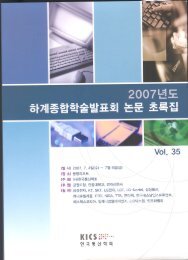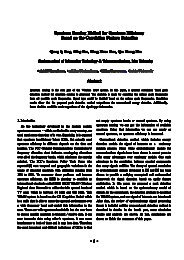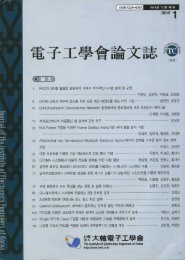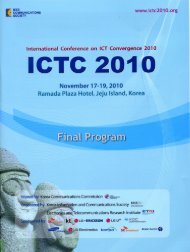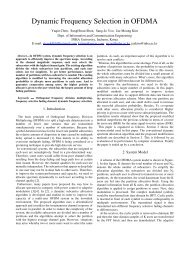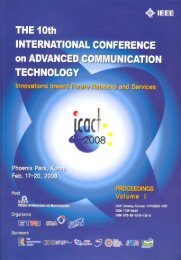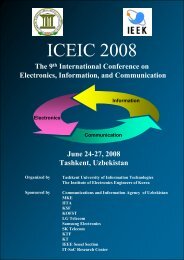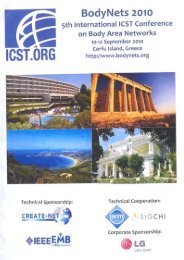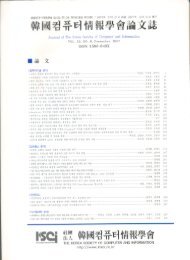Dynamic Frequency Allocation Based On Graph Coloring and Local ...
Dynamic Frequency Allocation Based On Graph Coloring and Local ...
Dynamic Frequency Allocation Based On Graph Coloring and Local ...
Create successful ePaper yourself
Turn your PDF publications into a flip-book with our unique Google optimized e-Paper software.
Block Probability<br />
1.00E+00<br />
1.00E-01<br />
Block Probability vs.Maximum Required Channel Number<br />
1.00E-02<br />
10 15 20 25 30 35 40 45 50 55<br />
Maximum Available Channel Number<br />
Fig.4 Block Probability vs. maximum required<br />
channel number (user number/cell =800)<br />
Block Probability<br />
1.00E+00<br />
1.00E-01<br />
1.00E-02<br />
Block Probability vs.Minimum Required Channel Number<br />
1 2 3 4 5 6 7 8 9<br />
Minimum Required Channel Number<br />
Fig.5 Block Probability vs. minimum required<br />
channel number (user number/cell =800)<br />
In our work, we consider only the spectrum allocation<br />
model <strong>and</strong> procedure without channel quality. So the<br />
simulation is only related to the allocation result,<br />
including the block probability versus the user number<br />
per cell, the maximum required channel number <strong>and</strong> the<br />
minimum required channel number. Fig. 3 shows the<br />
trend of block probability as user number per cell<br />
changing. Fig. 4 <strong>and</strong> Fig. 5 illustrate that the block<br />
probability is related to minimum required channel<br />
instead of maximum required channel because the<br />
algorithm guarantees the minimum required channel of<br />
users.<br />
E. CONCLUSION AND FURTHER WORK<br />
In this paper, we propose a spectrum allocation<br />
scheme called “pre-allocation <strong>and</strong> local bargaining” for<br />
multi-cell WRAN system. This scheme adopts the color<br />
sensitive graph coloring problem, regarding the users<br />
from different cells which will conflict with each other<br />
when they locate within constrained distance as the<br />
vertices in the graph. And each vertex should select<br />
appropriate colors without interfering with other users<br />
connected with it by constrained edge.<br />
In our scheme, the first stage is named “preallocation”,<br />
during which it is tried to allocate all users<br />
spectrum b<strong>and</strong>s as many as maximum requirement.<br />
Actually, some users would fail to get enough spectrum<br />
b<strong>and</strong>s, therefore, the second stage called “local<br />
bargaining” is processed to reduce the block probability<br />
or guarantee the minimum b<strong>and</strong>width requirement. The<br />
“local bargaining” has other advantages that it is capable<br />
to reduce the complexity for new arrival <strong>and</strong> mobile<br />
users.<br />
To evaluate our proposed scheme, computer<br />
simulation has been done. However, due to the lack of<br />
consideration about channel environment effects, our<br />
simulation results only give us an impression about the<br />
efficiency on block probability. To evaluate this model<br />
more precisely, other parameters should be considered<br />
during simulation such as the frequency domain channel<br />
response [5]. Therefore, adding <strong>and</strong> considering the<br />
practical channel effects is our further work.<br />
REFERENCES<br />
[1] Simon Haykin, “Cognitive radio: Brain-empowered wireless<br />
communications ”, in IEEE journals on selected areas in<br />
communications, vol.23, No. 2, February 2005, pp. 201-220.<br />
[2] Carl R. Stevenson, Carlos Cordeiro, Eli Sofer, Gerald Chouinard,<br />
“Functional requirements for the 802.22 WRAN st<strong>and</strong>ard”, Mar, 2006.<br />
[3] Lili Cao, Haitao Zheng, “Distributed spectrum allocation via local<br />
bargaining”, in IEEE SECON., 2005, pp.475-486.<br />
[4] Haitao Zheng, Chunyi Peng, “Collaboration <strong>and</strong> fairness in opportunistic<br />
spectrum access,” in Proc. 40 th annual IEEE international conference on<br />
communications., Jun, 2005, pp. 3132-3136.<br />
[5] Yuqin Chen, SungHwan Shon, Sang-Jo Yoo, Jae Moung Kim, “<strong>Dynamic</strong><br />
frequency selection in OFDMA”, ICACT,2006.



